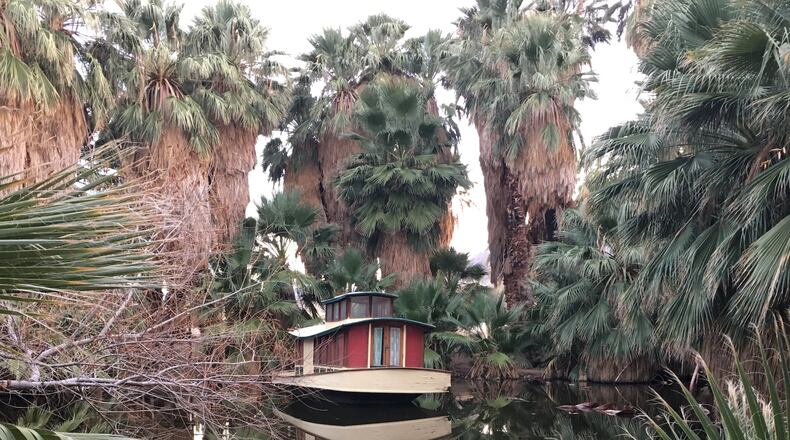Five minutes from downtown Palm Springs, a former Hollywood hangout where the ghosts of Dinah Shore and Bob Hope still stroll, five friends and I on a winter getaway filled our water bottles and smeared on sunblock at the trading post-themed Indian Canyons visitor center.
Our timing was perfect. A guided ranger walk was about to begin. We lined up and followed him single-file along the Palm Canyon Trail, from the sun-parched ridgetop into a shady canyon crowded with palms wearing thick crowns of waxy fronds and bare roots that reached toward shallow puddles and inky streams. I’d never seen an untrimmed palm before, and the ranger explained that the thick layers of dead fronds that eventually skirt the trunk form a habitat unto itself.
We hiked backward in time through a prehistoric landscape only minutes from what’s become a mecca for martini-sipping hipsters and devotees of midcentury-modern architecture.
I’d always bought into the misconception that Palm Springs was a dull desert getaway best suited for grays, golfers and gays (at least a combination of the two), so for many years I was a Palm Springs holdout. All that changed several years ago when a funky artist friend moved there full time for the spectacular weather (most of the year) and the getting-cooler-all-the-time culture. For me, it’s the city’s namesake that keeps me coming back: palms and the wet oases where they thrive.
Water in the desert? A mirage? Not a bit.
Palm Springs is home to some of the biggest palm oases in North America. These are my don’t-miss recommendations for the best.
———
INDIAN CANYONS
Where: Just a few minutes from downtown Palm Springs, Indian Canyons is the most convenient — and sometimes rugged — place to see the palm. The property, which includes thousands of acres and innumerable wild canyons, is owned and managed by the Agua Caliente Band of Cahuilla Indians, which also owns much of the land that is Palm Springs (that’s another story).
Getting around: Though there’s a mind-boggling network of 60 miles of trails, the Canyons site is most notable because it has an unusual number of natural springs that support several California fan palm groves. That includes the Palm Canyon Oasis, reputed to be one of the biggest in North America, which is accessed via the Palm Canyon Trail. But there’s a hike for everyone, ranging from an easy two-mile round trip that starts at the Andreas Canyon trailhead to a seven-mile round trip with 2,000 feet in elevation gain to the Maynard Mine, where tungsten was processed during World War II. Though there’s no palm oasis to be seen, it’s also worth checking out the Tahquitz Canyon, which has trails that lead to a desert mirage of its own: a stunning 60-foot waterfall.
What’s unique: A ranger walk or interpretive talk here is the best way to learn the basics about palm oases and why they thrive in this area. This is where I learned that palms aren’t really trees, and that you don’t have to travel to the Middle East to see a real oasis. The visitor center is a don’t-miss stop to explore the culture of the area. There are extensive displays where you’ll see more about the rock art, plants and animals in the area, and there’s a theater room where you can watch “The Legend of Tahquitz Canyon” and glean more about the area via cultural exhibits.
———
THOUSAND PALMS
Where: Ten miles east of Palm Springs, at the base of the Indio Hills, the Coachella Valley Preserve is a seemingly lifeless 18,000-acre wilderness area that’s home to the Thousand Palms Oasis, a lush habitat of palms where you can actually step across the San Andreas Fault via a short footbridge and watch water rise to the surface through various seeps, creeks and ponds. It’s the kind of dune-dotted, windswept landscape where you’d expect Lawrence of Arabia to ride past on a camel.
Getting around: This is the place to come if you want to see a completely intact, undeveloped palm oasis, but do it without a strenuous hike. Though there are dozens of miles of trails in the area, the two-mile (round trip) McCallum Palms Trail starts at the visitor center just a short walk from the parking lot. There’s also a rustic little three-room “palm house” that was home to Paul Wilhelm, a writer, naturalist and longtime champion of the oasis whose passion for this unique habitat is obvious. There are several hikes to oases, including the five- to six-mile (round trip) Pushawalla Palms Trail, which is moderately strenuous but offers a reward at the end: the Pushawalla Palms Oasis.
What’s unique: If you’re interested in native flora and fauna, this is the place to come. In addition to the rare pupfish that ply the ponds, the preserve is home to the Coachella Valley fringe-toed lizard, which can’t be found anywhere else in the world. There are no user fees — the preserve relies on donations and they allow hiking and picnics.
———
THE OASIS OF MARA
Where: The Oasis of Mara and the 29 Palms Inn are at the north entrance to Joshua Tree National Park, a moonscape-like landscape that’s about an hour from Palm Springs, making it a perfect day trip.
Getting around: The oasis is the heart of the 29 Palms Inn, a storied, one-of-a-kind getaway with a restaurant and adobe-style bungalow rentals, which is a perfect place for those with mobility issues because there’s a short, paved ADA-accessible pathway around the oasis. It’s also a perfect place to end a day of hiking in Joshua Tree, where there are miles of hiking trails and scenic drives. And geologically, it doesn’t get much more interesting than this part of California. This is where the Mohave and Lower Colorado deserts meet, and in addition to one of the most famous oases you’ll see armies of sentinel-like Joshua trees amid otherworldly boulder formations.
What’s unique: An oasis overnight. 29 Palms offers a wide range of inexpensive lodging options. During one visit I rented an adobe-style bungalow in a desert setting on the outskirts of the oasis. During that spring visit it was still cool enough to build a fire at night, but hot enough to take a dip in the pool. Several of the cottages have their own private patio, and some have lazy day hammocks. The inn has its own hobby farm and when seasonally appropriate the restaurant uses that produce in its food.
About the Author
Keep Reading
The Latest
Featured


